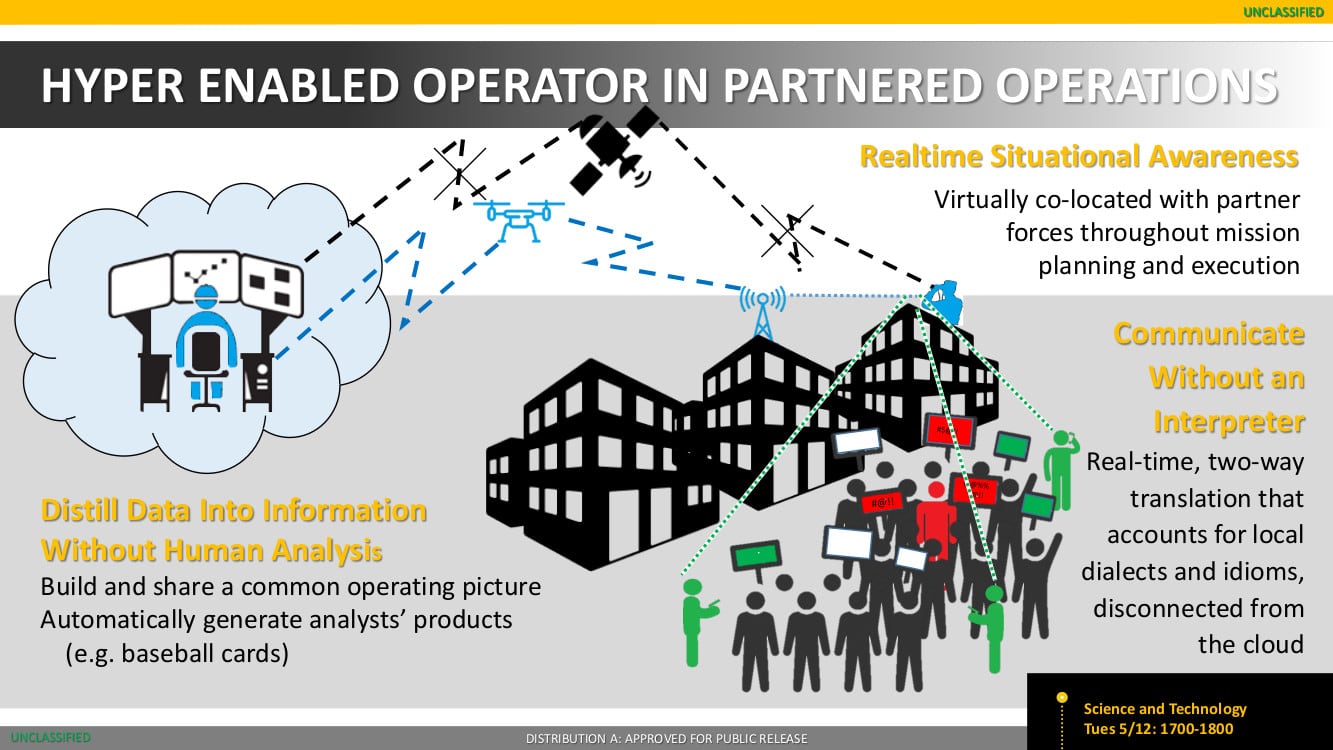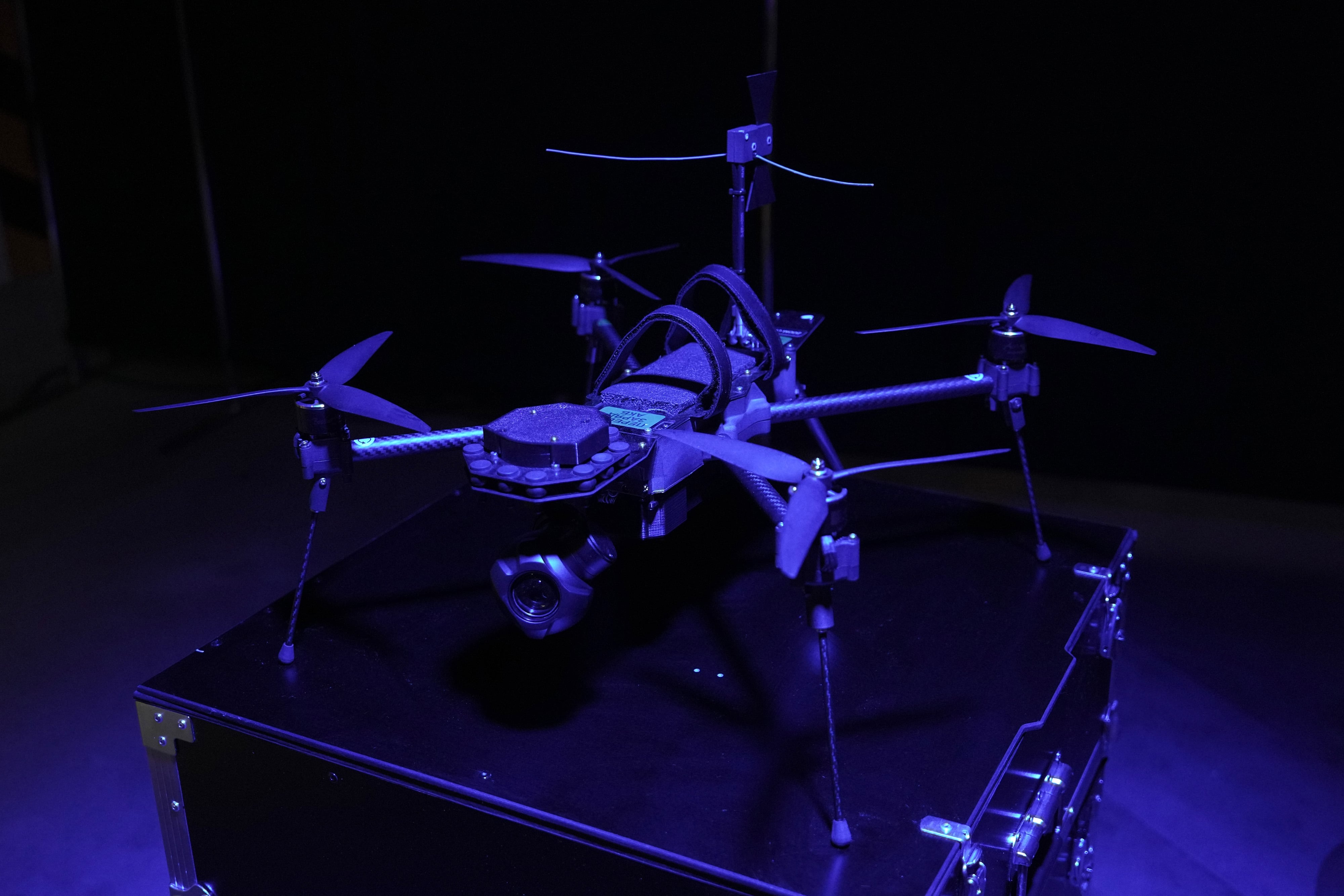Special Operations Command wants to bring the internet of things to the war fighter at the edge with their future war fighting concept—the Hyper Enabled Operator.
And while it’s easy to imagine SOCOM trying to invent a new super soldier a la Steve Rogers or a tech-enabled warrior in the vein of Iron Man — an idea the command has attempted in the not so distant past —the Hyper Enabled Operator has nothing to do with making the war fighter more physically adept. It’s about feeding data to the operator to help them make better decisions.
“You can hyper enable the operator in many many ways. You can give him a better pair of boots and you’re hyper enabling the operator. That’s not what we’re talking about. What we’re talking about in this case is improving their cognitive overmatch at the edge. And ‘at the edge’ for us, again, is this small unit individual operator operating in a remote, austere environment ... connected to an architecture that’s got to be applicable to that operator born environment—so really constrained. The ability to analyze, synthesize, communicate, all to enable the operator to make better decisions,” said SOCOM Acquisition Executive James Smith at the virtual Special Operations Forces Industry Conference May 12.
The Highly Enabled Operator replaces SOCOM’s five-year effort on the Tactical Assault Light Operator Suit.
SOCOM has created a Joint Acquisitions Task Force to develop the technology needed for the Hyper Enabled Operator. Col. Ryan Barnes is leading that team.
“What we’re trying to do is not necessarily increase physical performance, but it is in that cognitive domain,” said Barnes. “We’re looking to put the internet of things and data analytics on an operator at the edge so he can make more informed decisions faster. And we are looking to do that in the classic partner nations for internal defense, unconventional warfare scenarios.”
So, what are the technologies and solutions needed to create this cognitive overmatch?
Smith offers this example: Take a Special Forces war fighter by himself on a rooftop overlooking a rambunctious crowd. He is working with a partner force on the ground level around the crowd, and he also has connectivity to a tactical operations center. The operator needs to have those SOF-peculiar layers of analysis — sentiment, socioeconomic — to be effective. Is the crowd angry? What does it want? What are the instigators? What actions, if any, should be taken?
But how does this individual at the edge become a Hyper Enabled Operator?
In the near-term, the Hyper Enabled Operator needs more robust language translation applications.
Understanding what people in a crowd are saying is critical to developing SOF-peculiar layers such as sentiment analysis. While Special Operations Command has some language translation tools, they’re not nearly robust enough to interpret what’s happening at the edge, where some individuals in the crowd may have accents or dialects that render the translators useless.
“The language translators that we have are made for a pristine environment where someone is speaking the King’s English or the Premier’s Mandarin, or whatever you want to say,” said Smith. “We need language translation that works at the edge, that works with dialects, that works with accents, that can understand the guy from Jersey, for instance.”
Smith said SOCOM is looking to industry to help develop that robust language translation in the near-term.

And in the long term? Smith said they want to cut the analyst out of the equation.
The data the operator is collecting is transmitted back to analysts, who then look at it, think about it, transform it into an analytical product and disseminate it back to the operator. But that method is not fast enough or unique enough to build that cognitive overmatch the command’s leaders are looking for.
“It may get to our individual operator at the edge in a timely fashion, and it may be tailored for their situation, but probably not. If they get the data at all, they still have to do some level of their own analysis to figure out what the data means for them on that ground on that day,” said Smith.
To achieve the cognitive overmatch leaders want, the Hyper Enabled Operator needs analysis in near-real time, applied to their unique situation, and presented in an easily digestible format.
A solution like that may be a way off, but SOFWERX, a small factory that focuses on military innovation, plans to kick off its Automate the Analyst effort in June. Again, Smith said he is looking to industry for help.
That effort will be fueled by applying an internet of things approach for the war fighter. As Barnes explains, that internet of things is already present in everyday life.
“Ten years ago, you had all these devices in your homes—thermostats, microwave ovens, heaters, etc.—that worked just fine on their own,” Barnes said. “Somewhere along the line, someone wrote applications to run those and an architecture on which they could run together. So right now, I can sit in my car and adjust the thermostat in my house, turn on lights, start a microwave oven over the Alexa architecture, the Google architecture — there’s probably several more.”
But the sensors, communications devices and computers the war fighter carries into an operation do not interact in the same way.
“We don’t have a way for them to work collaboratively and collectively,” he said.
By applying an internet of things approach to those devices and increasing edge computing, Barnes hopes to build the Hyper Enabled Operator and cut out the middleman. In this case, the analyst.
“We are looking to put those types of sensors and communications devices on an operator, collecting information in the operational environment, catalog correlating that information, and then having analysis being done via advanced analytics in near-real time, returning to the operator — again, in near-real time — analytical products that previously would have had to go back to some type of higher echelon to be produced in hours, days or weeks, perhaps,” he explained.
The task force is looking for commercial off-the-shelf and government off-the-shelf products for this effort. Science and Technology Director Lisa Sanders added that the task force has full-time special operators to help define requirements for the concept.
“The Joint Acquisition Task Force is specifically focused against a specific problem,” said Sanders. “Their timeline is much closer. They’re more in the 18-month to three years—what could I take that’s available today that applies to a special operators’ mission.”
Below are the six lines of effort the task force is looking for help with to create a concept it calls the Hyper Enabled Operator:
- Operator Worn Compute Kit (OWK). Sensors/edge compute processing
- Application development
- Software defined, mission and hardware agnostic architecture
- Human Machine Interface (presentation layer)
- Information Realization This is what Sanders describes as a “…synthesis of products that are currently analyzed at higher echelons into products that can be digested at the tactical edge”
- Beyond Line of Sight Communications
Nathan Strout covers space, unmanned and intelligence systems for C4ISRNET.








